Page Published March 23, 2021 at 3:00 p.m.
Skagit County COVID-19 Data Report 2020
Editors: Lea Hamner, Communicable Disease & Epidemiology Lead
Laura Han, Public Information Officer
Introduction
Key Dates
Data:
Conclusion
Introduction
This report seeks to provide an empirical overview of Skagit County Public Health and Unified Command’s COVID-19 response in 2020. The first case of COVID-19 in the United States was found in Everett, Washington on February 21, 2020 and the first case of COVID-19 in Skagit County was confirmed on March 10, 2020. This report therefore covers the first full year of active COVID-19 response in Skagit County.
As a locale near the epicenter of the pandemic in the United States, Skagit County was on the frontlines of the pandemic from the very beginning. Public Health, Unified Command and Elected Leaders knew that it was important to respond quickly to the pandemic threat in order to prevent loss of life. As a government, tax-payer funded entity, Skagit County Public Health’s (Public Health) primary goal was ensuring that all Skagitonians had access to key services that would help to control the pandemic and prevent serious illness or loss of life. These priority services included up-to-date COVID-19 information, direction for isolation and quarantine, care coordination during isolation and quarantine, testing, and vaccination. Access for all has been a guiding principal of Public Health and Skagit County Unified Command’s response throughout the pandemic and will continue to be after we are able to return to a more normal post pandemic life in Skagit County.
The data in this report has been compiled by Public Health to provide an overall snapshot of the pandemic in Skagit County during 2020. The data helps us understand our response and will hopefully inform the community, local leaders and pandemic planning into the future.
Data helps us tell complicated stories, but it is not the whole story. What is not captured here are the tireless efforts of Skagit County staff, city staff, hospital partners and health care workers, elected leaders, community leaders and everyday residents. Some of these efforts were big and noticeable, like standing up COVID patient care in hospitals and clinics, staffing foodbanks, setting up basic-needs drives and providing countless volunteer and work hours to help the community survive. Some of these efforts were more quiet: staying isolated to protect the community from spread and the subsequent missed birthdays, weddings and other life events; making a point to wear a mask in public; supporting family and friends through the mental health, financial and other struggles that came along with the pandemic. While these are not captured here, Public Health sees them and is thankful for everything the community has done over the last year.
Key Dates
- January 23, 2020: Skagit County Public Health (hereafter abbreviated as Public Health) begins weekly meetings with hospitals to coordinate response to first COVID-19 case in the United States diagnosed in Everett, WA.
- February 24 – March 1 2020: Public Health begins to stand up Incident Command and drafts first Incident Action Plan for COVID-19 response. Entire department engaged in response efforts as time progresses. Skagit County Administration begins planning for county operations during pandemic.
- March 3, 2020: Public Health notified of a Skagit resident with COVID-19 symptoms.
- March 10, 2020: Public Health receives confirmatory laboratory results on the Skagit resident. This marks the first case of COVID-19 in a Skagit resident. Skagit implemented the Incident Command System and convened Unified Command.
- March 17, 2020: Public Health is notified of a potential outbreak related to a Skagit Valley Chorale group practice. This outbreak would lead to 53 cases, of which 2 members died. Public Health would later publish a report on the outbreak in the Centers for Disease Control (CDC)’s Morbidity and Mortality Week Report.
- March 20, 2020 Skagit County stands up a Unified Command Structure for county response. Unified Command established with Public Health, Department of Emergency Management, Mount Vernon Fire/EMS. First Situation Reports and Incident Organization Chart drafted under Unified Command.
- Skagit County Department of Emergency Management leads Logistics Section and begins supporting hospitals and long-term care facilities with personal protective equipment needs and establishes a public call center.
- March 2020 until present: Daily and then weekly briefings established for Health Branch, Unified Command, and Elected Officials regarding the COVID-19 response.
- March 2020: Public Health’s Housing Division works to establish an Isolation and Quarantine Facility to serve those who are unable to isolate or quarantine safely at home. A vacant motel in Burlington is leased for this purpose. Meals and daily check ins by Public Health are provided.
- March 26, 2020: Public Health makes their first recovery call to confirm that a patient was no longer experiencing COVID-19 symptoms.
- March 27, 2020: Public Health identified first long-term care outbreak and deployed their Long Term Care Team.
- March 30, 2020: Public Health establishes their Employer Response Team, which notifies businesses of employees who worked while infectious, when they can return to work, and how to prevent further spread. Public Health shared their protocols with neighbors and state due to the volume of follow up required.
- April 21, 2020: Skagit County Unified Command opens a high-volume, low barrier RT-PCR COVID-19 testing site at Skagit Valley College.
- April 2020: Department of Emergency Management as Logistics Section establishes volunteer recruitment and scheduling for testing site and coordinates site logistics support.
- June 11, 2020: Due to a high volume of cases and a need to prioritize staff elsewhere, Public Health stops making recovery calls.
- Summer through fall 2020: Public Health works closely with K-12 schools and child care facilities to plan for safe services according to state requirements.
- September 2020: Public Health begins formal planning for COVID-19 mass vaccination with Emergency Management, community and state partners.
- November 11, 2020: Due to a surge in cases in autumn, Public Health asks for support from the Washington State Department of Health to conduct contact tracing. Public Health continues to make initial notification calls on all cases, connects cases with resources so they can remain in isolation, and collects the most critical tracing information to expedite disease control.
- November 18, 2020: Skagit County Unified Command moves the testing site from Skagit Valley College to the Skagit Fairgrounds due to weather impacts to college site.
- December 2020: Public Health becomes a registered COVID-19 vaccine provider and prepares the Skagit County Fairgrounds as a COVID-19 Mass Vaccination Site. The vaccine clinic has built the capacity to vaccinate up to 940 people per day.
- December 29, 2020 Public Health administers their first vaccines to Phase 1A eligible healthcare workers.
- January 2021: Department of Emergency Management as Logistics Section supports Skagit County Fairgrounds Mass Vaccination Site with volunteer recruitment and scheduling and supply support. Skagit County Parks, Public Works, and Sheriff Departments also support the site.
- January 2021: Public Health and Emergency Management establish a COVID Vaccine hotline Monday through Saturday in English and Spanish supported with regular staff and volunteers coordinated through Emergency Management.
- March 8, 2021: Public Health confirms the first case of a B.1.1.7 (United Kingdom) variant in the county. It is likely that the variant has been circulating in the community for several weeks at this time.
- March 12, 2021: Public Health and Unified Command close the testing site in order to focus on vaccination efforts. Other testing providers are available in the community. At close, Public Health and Northwest Labs conducted nearly 44,000 PCR COVID-19 tests through the testing site.
- March 17, 2021: Public Health administers 10,000th dose of COVID-19 vaccine to date at mobile clinics and Skagit County Fairgrounds Mass Vaccination Site.
- March 22, 2021 Washington State moves to Phase 3 of Roadmap to Recovery re-opening.
Data
Unless otherwise noted, data has been compiled by Public Health employees.
Epidemiological Curve Data
In 2020, 3,399 COVID-19 cases were diagnosed in Skagit County that occurred in three distinct waves. These waves tracked closely with major holidays in the U.S., with the largest wave being in the late fall and winter of 2020 where holidays like Halloween, Thanksgiving, Hanukkah and Christmas brought large groups of people from separate households together indoors for long periods of time. Outside of transmission within households (30% of cases with a noted exposure source), the second largest source of infections were social events (17%), which are difficult to regulate.
Figure 1. Skagit County COVID-19 Cases by Day

This graphic comes from the Washington State Department of Health Data Dashboard. See the interactive dashboard, including 2021 data here.
Figure 2. Skagit County COVID-19 Cases by Month
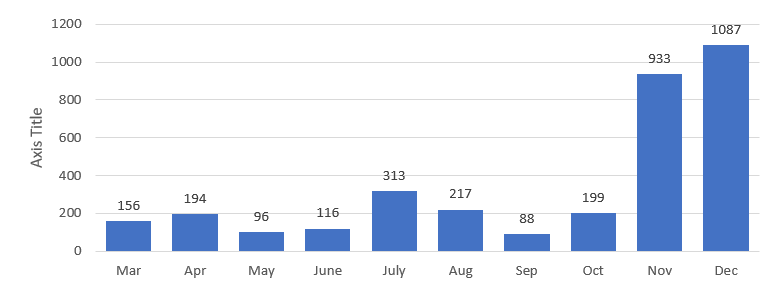
Skagit County Response Efforts Data
Skagit County Unified Command was one of the first response jurisdictions to set up a low-barrier test site where anyone could get tested for COVID-19. Though it closed on March 12, 2021, so that Public Health could focus on vaccination efforts, the test site was the longest continuously running low barrier site in the State.
Due to extremely high demand for testing early in the pandemic and a finite set of resources at Skagit County and Public Health’s disposal, Skagit County limited the use of the testing site to those who live in or work in Skagit County on August 31, 2020. During 2020, Unified Command conducted 39,257 PCR tests. Laboratory testing (and subsequent billing) for all samples collected at the test site was done by Northwest Laboratory in Bellingham, Washington.
While some Skagit County Public Health, Emergency Management, Sheriff Department, and Public Works staff were dedicated to the test site full time, volunteers supported the vast majority of operations.
Figure 3.Number of Tests Preformed and Percent Positivity at Skagit County Drive Through Test Site, by Month
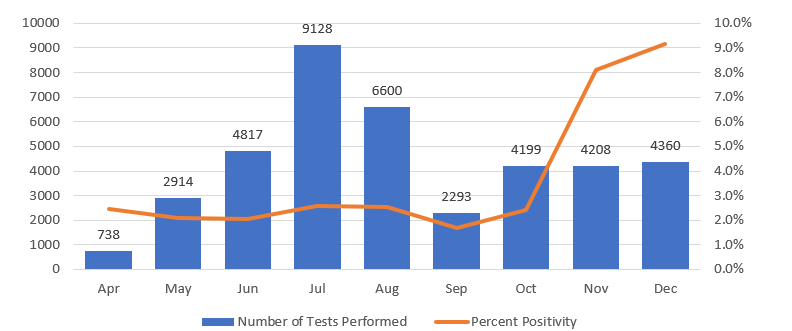
Figure 4. Number of Hours Volunteered to Support Skagit COVID-19 Response Efforts, by Month
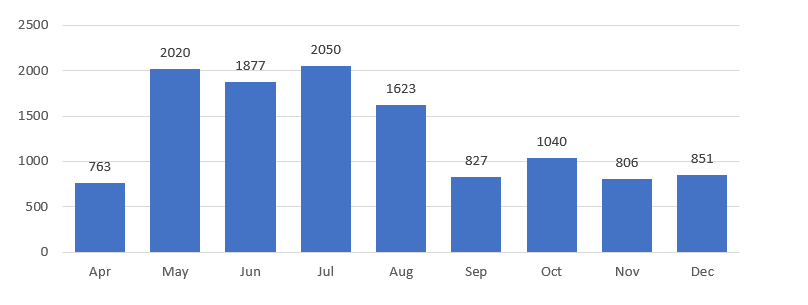
Case Investigation and Contact Tracing Data
When a COVID-19 case tests positive, prompt follow up is essential to disease control. Throughout the pandemic, Public Health has continued to reach cases quickly to trace potentially exposed contacts and locations and provide clear information on next steps. Public Health regularly met and exceeded the Governor’s goal of reaching 90% of cases within 24 hours. Out of 3,399 cases contacted in 2020, Public Health interviewed 92% within 24 hours. Only 3% of cases were lost to follow up and never located for an interview. Case interviews helped identify close contacts who were exposed to COVID-19 and could soon become infectious. Public Health identified and followed up on 3,899 close contacts and mailed 2,846 quarantine letters. Public Health also helped house cases and their contacts to help limit transmission in households. In total, 196 individuals took Public Health’s offer of housing in a hotel during their isolation or quarantine.
During the late fall-winter surge of 2020, Public Health asked for help from the Washington State Department of Health centralized investigations team. During this time of extremely high volume, Public Health prioritized case investigations and continued to make initial notification calls on all lab-positive cases to assess exposures to workplaces, school, and other high-risk settings. Public Health continues to offer housing, groceries, sanitation kits, and other resources to those under isolation or quarantine.
.
Table 1. Timeframe Between Initial Notification and Public Health Reaching a Case for Interview

Table 2. Timeframe Between Initial Notification and Public Health Reaching a Close Contact for Interview

Demographic Data
With regards to disease burden, COVID-19 did not affect every Skagit population equally. Those over 60 years of age accounted for 89 percent of all COVID-19 deaths in Skagit County, while at the same time only accounting for 17 percent of diagnosed cases.
Additionally, the Hispanic population in Skagit bore considerable burden. Per capita, the Hispanic community had 4.5 times more cases, compared to white, non-Hispanics (case rates of 6,624.2 and 1,470.4 cases per 100,000 population, respectively.)
There are many lessons to be learned in this data, particularly around racial equity and social determinants of health for non-white Skagitonians. Public Health continues to look for ways to create more equitable health outcomes for non-white residents in the context of COVID-19 and beyond.
Table 3. Skagit COVID-19 Cases, Hospitalizations and Deaths, by Age
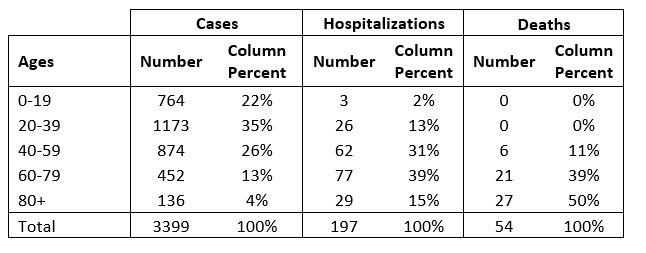
Figure 5. Age Distribution of Skagit COVID-19 Cases, Hospitalizations and Deaths
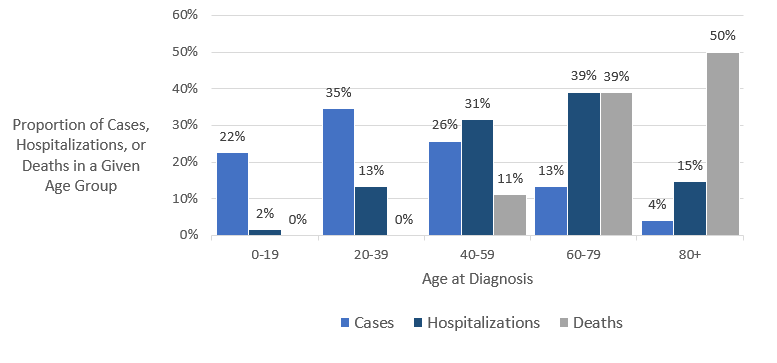
Table 4. Skagit COVID-19 Cases, By Geography of Residence
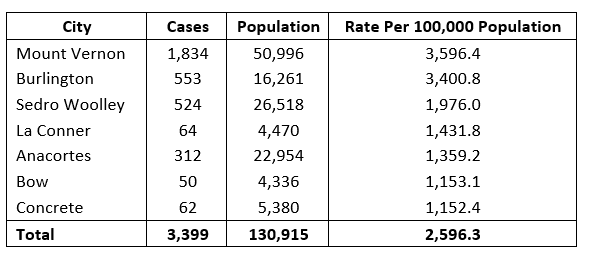
*** Note: Sorted from highest case rate to lowest. Due to small numbers, some geopgraphies are combined. Sedro-Woolley data includes Hamilton and Lyman. Mount Vernon data includes Clearlake and Conway. Concrete data includes Marblemoutn and Rockport. Population estimates from the American Community Surve 2019 5-year estimates.
Table 5. Skagit COVID-19 Case and Rates per 100,000 Population, but Race and Ethnicity

**Note: Sorted from highest case rate to lowest. 327 cases had no information on race or ethnicity. Population estimates from the American Community Survey 2019 5-year estimates.
Figure 6. Skagit County COVID-19 cases per Month, by Ethnicity
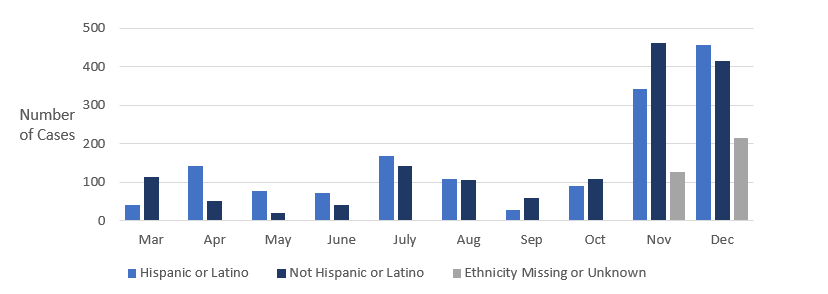
** Note: Due to small numbers and concerns for patient confidentiality, race cannot be disaggregated by month.
Figure 7. Skagit County COVID-19 Cases by Ethnicity, proportion of cases by Month
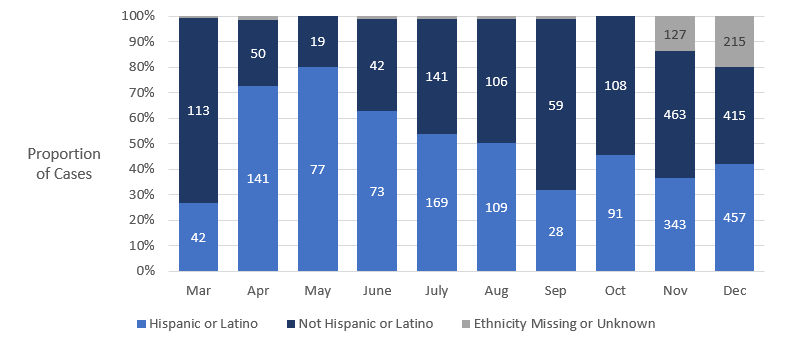
**Note: Data label note the number of cases diagnosed in that enthnicty group.
Outbreak Data
Public Health uses the state definition of outbreaks. In Long Term Care Facilities during 2020 an outbreak was defined as one case. In all other settings outside of a household gathering, two or more cases in a single setting with plausible transmission is considered an outbreak. The most notable outbreak in Skagit has been the Skagit Valley Chorale outbreak. Additional information on this specific outbreak was published in the CDC’s Morbidity and Mortality Weekly Report on May 15, 2021. You can find that report here.
Due to the way COVID-19 spreads, outbreaks were most common in workplaces or facilities where workers and/or residents were required to be together in close quarters for extended periods of time. Additionally, outbreaks do not exist separate from community spread. The higher the disease circulation is in a community, the more likely the disease will be introduced to a congregate setting, leading to an outbreak. Given that many facilities, such as Long Term Care, grocery stores, and agricultural processing facilities, are essential to basic societal functions, mitigation measures in other places (such as private social gatherings) were necessary to keep these facilities from additional outbreaks and/or harm. Public Health followed up anytime someone worked, attended a school, or visited a facility while infectious to identify close contacts, provide technical assistance on preventing spread, refer individuals for testing, and prevent or contain outbreaks. In 2020, Public Health followed up on 1,134 cases that worked or attended school while infectious. In total, 19% of cases (642 individuals) were associated with 92 outbreaks declared in 2020.
Further, several industries that were impacted by outbreaks have significant populations of Hispanic workers, which partially explains why the disease burden on this Hispanic community was so high throughout 2020.
Figure 8.Size of COVID-19 Outbreaks in Skagit County
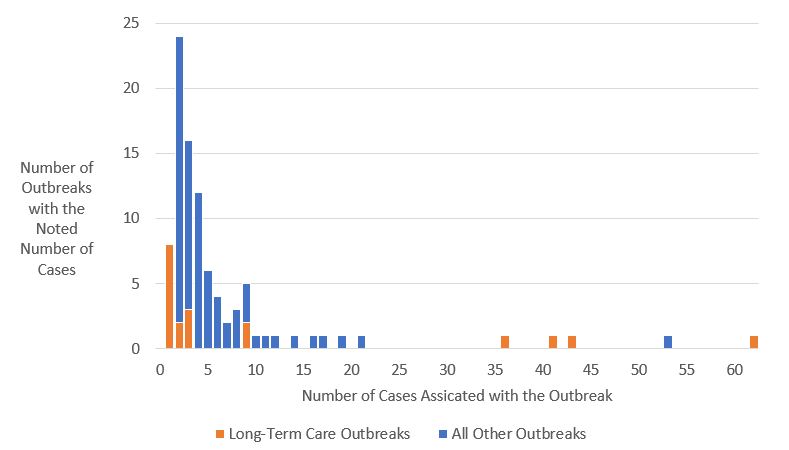
Table 6. Skagit County COVID-19 Outbreak Settings
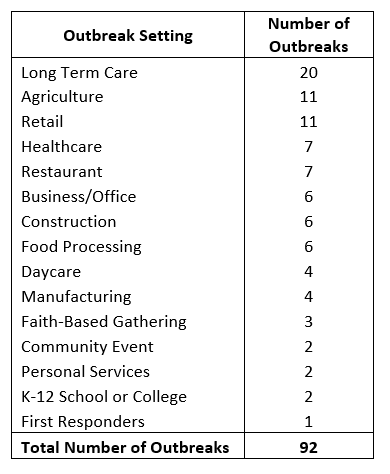
Conclusion
Public Health, Skagit County Department of Emergency Management and their partners will continue to respond to the COVID-19 pandemic until the disease is declared no longer in a pandemic state in the U.S. As much as Public Health and the community at large have learned about the COVID-19 virus, more continues to emerge. During 2021, Public Health will continue to monitor COVID-19 variants and ongoing research on long-term vaccine efficacy. It is a privilege to serve the community during this time.
For more information on Skagit’s COVID-19 response, please visit www.skagitcounty.net/coronavirus. If you have questions or need additional information about the data presented in this report, please contact the Health Department at eh@co.skagit.wa.us or at 360-416-1500.
|

































